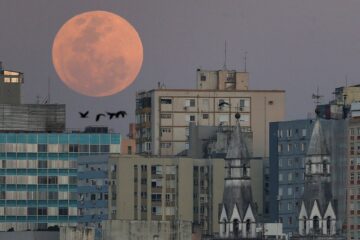Katrina Miller in The New York Times:
 I had two memorable experiences with the moon this year. The first was seeing the “blue supermoon” rise over Lake Michigan in August. The second, a few weeks later, was watching it quietly slip in front of our sun, casting the world below in an eerie, ethereal glow. Both of these moments left me with a sense of awe that I was not expecting. Frankly, I’ve always found the moon a bit boring. If you could study anything in the universe, I thought — the depths of black holes, faraway stellar explosions, or ghostlike particles called neutrinos, as I did — why on Earth would you ever pick the unmysterious moon?
I had two memorable experiences with the moon this year. The first was seeing the “blue supermoon” rise over Lake Michigan in August. The second, a few weeks later, was watching it quietly slip in front of our sun, casting the world below in an eerie, ethereal glow. Both of these moments left me with a sense of awe that I was not expecting. Frankly, I’ve always found the moon a bit boring. If you could study anything in the universe, I thought — the depths of black holes, faraway stellar explosions, or ghostlike particles called neutrinos, as I did — why on Earth would you ever pick the unmysterious moon?
But the science writer Rebecca Boyle proved me wrong. In “Our Moon,” Boyle walks the reader through a history of both Earth and humanity, from the formation of our planet and the evolution of life to the development of civilization, religion, philosophy and, eventually, science. And through it all, she argues, the moon has played a starring role in how we came to be, and who we are.
“The moon is more sibling than subordinate,” Boyle writes, explaining that it formed out of the same cosmic cloud of debris that made Earth. Its gravity not only stabilizes our climate — making the moon “captain of our seasons” — but also enabled life. As ruler of the tides, the moon pulled primitive organisms into early Earth’s nutrient-rich seas, then pushed them back onto shore where “the fish, out of water, walked.”
More here.
